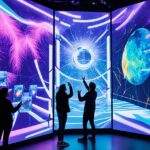Table of Contents
Welcome to the fascinating world of interactive design, where the internet has evolved from its humble beginnings to the cutting-edge technology we know today. Over the years, the digital landscape has undergone several revolutions, from the static Web 1.0 to the dynamic Web 2.0, and now the promising future of Web 3.0.
In the early days of the internet, Web 1.0, also known as the static web, brought us static websites that offered limited interaction and one-way communication. Websites built using HTML and CSS focused primarily on delivering information to users, lacking the interactive experiences that we are accustomed to today.
However, the advent of Web 2.0 revolutionized the online landscape, introducing user-generated content, social media platforms, and dynamic web applications. This shift empowered users to actively engage with the internet, creating their own content, participating in online communities, and enjoying personalized experiences.
Looking ahead, Web 3.0, also referred to as the semantic web, promises to take interactive design to new heights. With the integration of artificial intelligence, decentralized platforms, and semantic web technology, Web 3.0 aims to create a more intelligent, personalized, and secure online environment.
As you delve deeper into this article, we will explore the distinctive features and limitations of each web version, compare their impact on business and user experiences, and shed light on how the evolution of interactive design has shaped our digital world. Join us on this journey through the past, present, and future of web development.
Web 1.0: The Ancestor of the Internet
Web 1.0 was the first version of the web and laid the foundation for the internet we use today. It was a static web, where users could only passively consume information without the ability to interact. Websites were designed using HTML and CSS, and the focus was on providing information rather than creating interactive experiences.
The limitations of Web 1.0 included the lack of social media, user-generated content, and dynamic web pages. Despite these limitations, Web 1.0 played a crucial role in shaping the internet as we know it today.
“Web 1.0 was the era of publishing, where the web was viewed as a static library of information. It was a time when businesses and individuals could establish their online presence and share information with the world. However, the lack of interactive features and user-generated content limited the overall user experience.”
Although web design during this period was primarily focused on providing information, it paved the way for the future development of more dynamic and interactive web experiences. The simple yet functional website design principles from Web 1.0 formed a solid foundation for the evolution of web technologies.
Image:
The Evolution of Website Design in Web 1.0
Website design during the Web 1.0 era was characterized by its simplicity and reliance on HTML and CSS. The focus was on delivering information to the user in a straightforward and accessible manner.
The limitations of Web 1.0 website design restricted the utilization of complex features and interactivity commonly seen in modern web development. However, these limitations also resulted in websites that loaded quickly and provided a consistent user experience across different browsers.
A Comparison of Web 1.0, Web 2.0, and Web 3.0
| Aspect | Web 1.0 | Web 2.0 | Web 3.0 |
|---|---|---|---|
| Interactivity | No interactivity | User-generated content, interactive experiences | Advanced interactivity through AI and decentralized platforms |
| Website Design | Static web pages | Dynamic web applications | Personalized and intelligent design |
| Focus | Information delivery | User engagement | Machine-understandable data and personalized experiences |
Web 2.0: The Rise of Interactivity and User Engagement
Web 2.0 brought about a significant shift in the internet landscape, prioritizing user engagement and interaction. This version of the web empowered users to create and share their own content, leading to the rise of user-generated platforms, social media, and online communities.
Web 2.0 sites were designed with the user in mind, offering dynamic and interactive experiences through innovative technologies like AJAX and CSS. The static web pages of Web 1.0 gave way to dynamic web applications, enabling collaboration, social networking, and personalized user experiences.
With the advent of Web 2.0, individuals became active participants in shaping the internet. They could not only consume information but also contribute their own thoughts, ideas, and content. User-generated content became a driving force behind the success and popularity of platforms such as Wikipedia, YouTube, and blogging websites.
The rise of social media platforms like Facebook, Twitter, and Instagram further enhanced user engagement, connecting people from around the world and enabling them to share their experiences, opinions, and valuable insights. The concept of social networking became embedded in the fabric of the digital world, facilitating communication and community-building on an unprecedented scale.
Web 2.0 also introduced the concept of the dynamic web, where websites could update content in real-time, providing users with the most relevant and up-to-date information. This dynamic nature of the web created a more immersive and personalized user experience, catering to individual preferences and enhancing overall satisfaction.
Technological advancements in Web 2.0 allowed for seamless integration of multimedia elements such as images, videos, and audio. Websites became more visually appealing and interactive, capturing users’ attention and encouraging them to explore and engage with the content.
Overall, Web 2.0 revolutionized the internet by putting users at the forefront, transforming them from passive consumers to active participants. The emphasis on user-generated content, social media, and dynamic web experiences paved the way for the digital landscape we know today.
| Features | Web 1.0 | Web 2.0 |
|---|---|---|
| Interactivity | Limited or one-way communication | Ongoing user engagement and interaction |
| Content Creation | Developed by few content creators | User-generated content and collaboration |
| Communication | Traditional media channels | Social media platforms and online communities |
| Web Design | Static and HTML-based | Dynamic and CSS-driven |
| User Experience | Limited personalization | Highly personalized and interactive |
Web 3.0: The Future of the Internet
Web 3.0, also known as the semantic web, is set to shape the future of the internet. Building upon the advancements of its predecessors, Web 3.0 aims to transform the way we interact with digital content by making data not only human-readable but also machine-understandable.
Incorporating cutting-edge technologies like artificial intelligence, natural language processing, and the Internet of Things, Web 3.0 enables a personalized and relevant digital experience. By leveraging the power of AI, websites and applications can provide tailored recommendations, intelligent search results, and interactive conversational interfaces. This seamless integration of technology will revolutionize the way we consume and interact with online content.
One of the key focuses of Web 3.0 is decentralization. By utilizing blockchain technology and decentralized platforms, Web 3.0 ensures enhanced privacy, security, and transparency. Users can have greater control over their data and trust in the integrity of online transactions. Decentralized platforms also foster collaboration and innovation by removing the need for intermediaries, empowering individuals and communities to shape the digital landscape.
Web 3.0 sites will offer advanced applications and personalized content, transforming the internet into a dynamic and intelligent environment. With the ability to understand context, semantics, and user preferences, the semantic web will enable information and services that are tailored to individual needs.
As the evolution of interactive design continues, Web 3.0 holds the promise of a more connected, intelligent, and decentralized internet. It is an exciting glimpse into the future of digital experiences, where technology seamlessly integrates into our lives to provide personalized and meaningful interactions.
Comparison between Web 1.0, Web 2.0, and Web 3.0
Web 1.0, Web 2.0, and Web 3.0 have distinct characteristics and have contributed to the evolution of the internet. Let’s take a closer look at each version and compare their features:
Web 1.0: The Static Web
Web 1.0, also known as the static web, was the first version of the internet. It focused on delivering information through basic websites designed with HTML and CSS. Users could only passively consume content without any interaction. This version had limitations such as the absence of social media, user-generated content, and dynamic web pages.
Web 2.0: The Era of User Engagement
Web 2.0 revolutionized the internet by introducing user-generated content and interactivity. It enabled users to create, share, and collaborate on content, leading to the emergence of social media platforms, blogs, and online communities. Technologies like AJAX and CSS made websites more dynamic and interactive, offering personalized experiences and fostering online user engagement.
Web 3.0: The Future of Online Experience
Web 3.0 takes the internet to the next level by incorporating semantic web technology, artificial intelligence, and decentralization. It focuses on making data accessible and understandable not just to humans but also to machines. Web 3.0 utilizes advanced technologies like AI, natural language processing, and the Internet of Things to create personalized and relevant digital experiences. This version ensures privacy, security, and transparency through decentralized platforms powered by blockchain technology.
The comparison between Web 1.0, Web 2.0, and Web 3.0 reveals the remarkable advancements made throughout the history of the internet. From static information delivery to user-generated content and now evolving towards highly personalized experiences, each version has significantly impacted the way we use the internet. The digital landscape continues to transform, and our interactions, content creation, and online experiences reflect the continuous evolution of the web.
Now, let’s summarize the impact of Web 3.0 on business and users…
Impact of Web 3.0 on Business and Users
The emergence of Web 3.0 has had a profound impact on both businesses and users, transforming the entire digital landscape. This next iteration of the web introduces revolutionary technologies such as blockchain and artificial intelligence, enabling personalized experiences and driving significant advancements in various industries.
Blockchain: Secure and Transparent Transactions
One of the key features of Web 3.0 is blockchain technology. By leveraging decentralized and distributed networks, blockchain ensures secure and transparent transactions without the need for intermediaries or centralized control. This has revolutionary implications for industries such as finance and supply chain management, where trust, security, and transparency are paramount. Blockchain enables faster, more efficient, and cost-effective transactions, ultimately transforming traditional business models.
Artificial Intelligence and Personalized Experiences
Artificial intelligence (AI) plays a crucial role in Web 3.0, offering businesses the ability to enhance user experiences and gain insights into consumer behavior. Using AI algorithms and big data analytics, businesses can personalize content, recommendations, and interactions based on user preferences and behavior patterns. This level of personalization not only improves user satisfaction but also enables businesses to deliver targeted messaging and optimize marketing strategies.
Automation and Streamlined Processes
Web 3.0 harnesses the power of AI to automate manual and repetitive tasks, streamlining processes and increasing operational efficiency. By automating routine processes, businesses can free up valuable resources and focus on more strategic initiatives. Automation also reduces the risk of human error, improves consistency, and enhances productivity, leading to cost savings and improved business outcomes.
“Web 3.0 creates a more connected and personalized digital environment, improving user experiences and transforming the way businesses operate.”
In summary, the impact of Web 3.0 on business and users is immense. Blockchain technology ensures secure and transparent transactions, revolutionizing industries such as finance and supply chain management. Artificial intelligence enables personalized experiences, allowing businesses to tailor content and interactions to individual users. Additionally, the automation capabilities of Web 3.0 streamline processes and improve operational efficiency. As Web 3.0 continues to evolve, businesses must adapt to these changes to stay ahead in the digital age.
| Impact of Web 3.0 | Examples |
|---|---|
| Secure and Transparent Transactions | Blockchain in finance and supply chain management |
| Personalized Experiences | AI-driven content recommendations and targeted messaging |
| Automation and Streamlined Processes | Automating routine tasks to improve efficiency |
Conclusion
The evolution of interactive design from Web 1.0 to Web 3.0 has completely revolutionized the internet and how we engage with it. Web 1.0 laid the foundation for the digital landscape we know today, with basic static websites providing limited interaction. Web 2.0 brought about a fundamental shift by introducing user-generated content, social media platforms, and dynamic web experiences. Now, we are on the cusp of Web 3.0, where advanced technologies like artificial intelligence and blockchain are poised to redefine the digital world.
Understanding the evolution of interactive design is crucial for individuals and businesses to adapt to the ever-changing digital landscape. With each iteration, the internet has become more interconnected, personalized, and intelligent. From simply accessing information on Web 1.0 to actively participating in user-generated content platforms on Web 2.0, the evolution has empowered users to create, connect, and collaborate.
Web 3.0 holds immense potential with technologies like artificial intelligence and blockchain. It promises a more personalized user experience, enhanced security and transparency, and advanced applications. Embracing Web 3.0 is key to unlocking the full potential of the internet and harnessing its advantages in various industries, from finance to healthcare, from retail to education.
In conclusion, the journey from Web 1.0 to Web 3.0 has completely transformed the way we interact with the digital world. It is a testament to our evolving needs and expectations as users. As we move forward, staying informed and adaptable is essential to navigate the constantly evolving digital landscape and tap into the limitless possibilities that the future of interactive design holds.
FAQ
What is the evolution of interactive design?
The evolution of interactive design refers to the process of how web design and user experiences have progressed over time, from the static web of Web 1.0 to the more interactive and personalized experiences of Web 2.0 and Web 3.0.
What is Web 1.0?
Web 1.0, also known as the static web, was the first version of the internet where users could only passively consume information without the ability to interact. Websites during this era were characterized by basic design using HTML and CSS, with a focus on information delivery rather than interactivity.
What is Web 2.0?
Web 2.0 represents the second stage of the internet evolution, bringing user-generated content, social media, and interactive experiences. It introduced dynamic web applications, collaboration, and personalized user experiences through technologies like AJAX and CSS.
What is Web 3.0?
Web 3.0, also known as the semantic web, is the future of the internet. It incorporates advanced technologies such as artificial intelligence and the internet of things to create a more personalized and relevant digital experience. Web 3.0 also focuses on decentralization through blockchain technology for privacy, security, and transparency.
How do Web 1.0, Web 2.0, and Web 3.0 compare?
Web 1.0, Web 2.0, and Web 3.0 have distinct characteristics and have contributed to the evolution of the internet. Web 1.0 was static and focused on information delivery, while Web 2.0 introduced interactivity and user-generated content. Web 3.0 takes it a step further by incorporating semantic web technology, artificial intelligence, and decentralization.
What is the impact of Web 3.0 on business and users?
Web 3.0 has brought significant changes to the business and user landscape. It enables secure and transparent transactions through blockchain technology, revolutionizing industries such as finance and supply chain. Additionally, artificial intelligence and big data allow businesses to personalize experiences, gain insights into consumer behavior, and automate processes.













